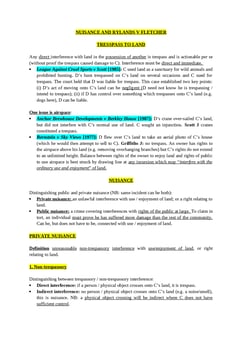Rylands v Fletcher [1868] LR 3 HL 330
Judgement for the case Rylands v Fletcher
KEY POINTS
A person who brings onto their land and keeps there anything that is likely to do mischief if it escapes is strictly liable for any damage that results from its escape, even if they took all reasonable precautions.
While the ruling in this case imposes strict liability, it also admits of exceptions, such as acts of God and acts of a third party. If the escape of the dangerous thing is due to these factors, a defendant may not be held liable.
FACTS
The Defendants, owners of a mill, planned to build a reservoir near the Plaintiff's land. Below the Defendants' land were old mining passages and shafts that had been filled with soil and debris. The Plaintiff's mining activities eventually connected with these abandoned works.
The Defendants constructed the reservoir with the help of engineers and contractors who didn't take proper care given the filled shafts. When the reservoir was filled with water, the pressure caused the old shafts to break, flooding the Plaintiff's mine and causing significant damage.
The initial court ruled in favour of the Defendants, but the Court of Exchequer Chamber unanimously concluded that the Plaintiff had a valid claim for damages.
JUDGEMENT
Appeal dismissed.
COMMENTARY
This case continues to have an impact on tort law, particularly in situations where there is environmental damage, risky behaviour, or property damage brought on by dangerous material escapes.
When certain requirements are met, it serves as a precedent for imposing strict responsibility, but its application frequently necessitates careful analysis of the unique facts and circumstances of each case.
ORIGINAL ANALYSIS
Defendant had permission to build a water mill on his land and employed reputable engineers to do it. The engineers came across some old mine shafts during the work but didn’t seal them properly with the result that water from the mill flooded the mine on the neighbouring land.
HL held Plaintiff liable for the engineers’ lack of care - strict liability.
Lord Cairns LC
In cases where damage is done by the operation of nature, e.g. if water had naturally accumulated, Defendant would not be liable.
However, where Plaintiff brings something onto his land which is not there naturally, and, as a result of the imperfect manner in which they do so, then the defendant’s actions were at his own peril. If therefore an evil arises which injures Plaintiff or Plaintiff’s land, Defendant is liable.
He endorses Blackburn J’s decision in the court below.
Blackburn J (in court below but endorsed by HL: judges)
A person who brings something onto his land likely to do mischief if it escapes must keep it at his peril. He is prima facie liable for any damage naturally consequent upon its escape. He can escape liability where Plaintiff caused the escape or vis maior or an act of god.
This is just: If A’s cattle escapes and ruins B’s crops, then A should pay. Same is true, for example, of filth from one’s privy or fumes, et.c
RELATED CASES
For Further Study on Rylands v Fletcher
Need instant answers? Our AI exam tutor is here to help.
Ask questions 🙋 Get answers 📔 It's simple 👁️👄👁️
Our AI is educated by the highest scoring students across all subjects and schools. Join hundreds of your peers today.
Get StartedSimilar Cases
Related Product Samples
These product samples contain the same concepts we cover in this case.
| Tort Law | Nuisance Notes (70 pages) |

 Since 2010, Oxbridge Notes has been a trusted education marketplace, supplying high-quality materials from top achievers at universities like Oxford, Cambridge, LSE, Harvard, and Yale.
Since 2010, Oxbridge Notes has been a trusted education marketplace, supplying high-quality materials from top achievers at universities like Oxford, Cambridge, LSE, Harvard, and Yale.